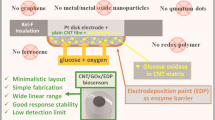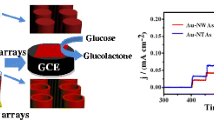Abstract.
Aligned multi-wall carbon nanotubes (MWNT) grown on platinum substrate are used for the development of an amperometric biosensor. The opening and functionalization by oxidation of the nanotube array allows for the efficient immobilization of the model enzyme, glucose oxidase. The carboxylated open-ends of nanotubes are used for the immobilization of the enzymes, while the platinum substrate provides the direct transduction platform for signal monitoring. It is also shown that carbon nanotubes can play a dual role, both as immobilization matrices and as mediators, allowing for the development of a third generation of biosensor systems, with good overall analytical characteristics.
Similar content being viewed by others
Author information
Authors and Affiliations
Additional information
Electronic Publication
Rights and permissions
About this article
Cite this article
Sotiropoulou, S., Chaniotakis, N.A. Carbon nanotube array-based biosensor. Anal Bioanal Chem 375, 103–105 (2003). https://doi.org/10.1007/s00216-002-1617-z
Received:
Revised:
Accepted:
Issue Date:
DOI: https://doi.org/10.1007/s00216-002-1617-z




